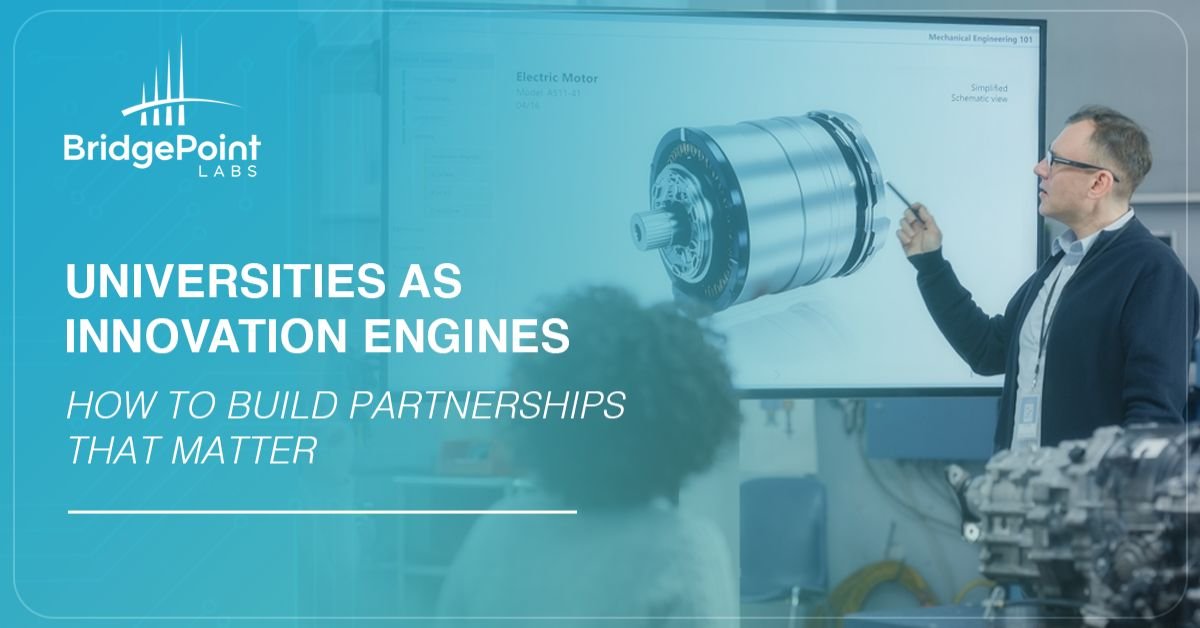In 2025, universities are no longer just centers of academic excellence—they’re now vital drivers of regional economic development, national competitiveness, and startup formation. For tech startups, corporate R&D teams, and federal agencies, universities have become critical partners in solving complex challenges and commercializing frontier technologies.
But building effective university partnerships isn’t just about licensing IP or finding talent. It’s about understanding how to navigate ecosystems, align with institutional goals, and co-create value at the intersection of research, innovation, and impact.
Why Universities Matter More Than Ever
Universities bring a unique mix of assets that are hard to replicate elsewhere:
- Cutting-Edge Research and IP Pipelines: Federally funded research at institutions across the U.S. yields thousands of patents and prototypes each year—many in AI, quantum, biotech, and energy.
- Deep Talent Pools: Top students, postdocs, and faculty provide a steady stream of future founders, engineers, and domain experts.
- Innovation Infrastructure: University-affiliated incubators, testbeds, cleanrooms, and labs lower the cost of prototyping and experimentation.
- Non-Dilutive Funding Leverage: Research partnerships often unlock access to government grants and cooperative agreements not available to companies alone.

The New University Model: From Lab to Launch
Leading universities are redesigning how they engage with external partners:
- Tech Transfer Offices Becoming Venture Studios: Instead of passively licensing IP, many TTOs now co-develop companies, recruit CEOs, and de-risk technology through translational funding.
- Centers of Excellence and Interdisciplinary Labs: AI, climate, and national security-focused research centers offer applied collaboration opportunities with shared governance models.
- Industry Partnership Programs: Corporations can now “subscribe” to university innovation networks to gain early access to research, students, and co-development channels.
- University-Driven SBIR/STTRs: Academic labs often serve as the R&D engine on collaborative SBIRs, helping startups win Phase I/II funding with strong technical proposals.
Challenges to Getting It Right
Despite the opportunity, many startups and companies struggle with university partnerships. Common friction points include:
- Misaligned Timelines: Startups operate in months; universities often work in semesters or fiscal years.
- Opaque Processes: IP licensing, conflict-of-interest reviews, and IRB approvals can be complex and slow without insider guidance.
- Unclear Incentives: Academic motivations (e.g., publications, tenure) don’t always align with market-driven outcomes.
- Cultural Gaps: Entrepreneurs and faculty researchers often speak different languages and operate under different constraints.
How to Build High-Impact University Collaborations
At BridgePoint Labs, we recommend a four-part approach to structuring strong academic-industry partnerships:
1. Start with Shared Purpose
Focus on problems both sides care about—whether it’s sustainable energy, defense readiness, or AI ethics. Co-create projects that support both societal impact and academic advancement.
2. Design with Funding in Mind
Align collaboration with joint funding opportunities—such as NSF Convergence Accelerators, DoD UARCs, DOE university consortia, or philanthropic initiatives.
3. Structure for Speed and Accountability
Use pre-negotiated templates, joint steering committees, and milestone-based funding to ensure projects move forward with clear deliverables.
4. Go Beyond Licensing
Look for engagement models like:
- Sponsored research agreements
- Visiting scholar/entrepreneur-in-residence programs
- Joint ventures and spinouts
- Talent pipelines and experiential education partnerships

How BridgePoint Labs Helps
BridgePoint Labs specializes in bridging the gap between innovation-driven organizations and research institutions. We help:
- Tech companies identify the right university partners for collaborative R&D, workforce development, or pilot testing
- Startups integrate university faculty or facilities into SBIR/STTR proposals and joint development strategies
- Universities expand their external engagement strategies and develop mission-aligned innovation centers
- Investors and philanthropies find academic collaborators for thematic initiatives in climate, defense tech, AI, and life sciences
Case Studies
- A CleanTech startup worked with a university microgrid lab to test its energy optimization software—securing an $800K DOE grant with BridgePoint’s help
- A regional HBCU launched a public-private innovation consortium focused on quantum tech with support from our strategic planning team
- A biotech spinout from a university cancer lab gained NIH SBIR Phase II funding after a BridgePoint-led commercialization strategy workshop
Key Takeaways
- Universities are no longer passive players—they’re essential innovation partners
- Startups, governments, and companies can leverage academic R&D to de-risk tech development
- Successful partnerships require aligned goals, flexible structures, and clear expectations
- BridgePoint Labs helps build those bridges—turning potential into performance
Innovation Starts with Collaboration
At BridgePoint Labs, we believe that the future of technology depends on building dynamic ecosystems across sectors. If you’re a startup looking to tap into university talent or a university leader looking to expand impact, we can help craft the roadmap.
Let’s connect knowledge to outcomes.



